梵蒂冈介绍英语ppt
- 格式:ppt
- 大小:11.61 MB
- 文档页数:17


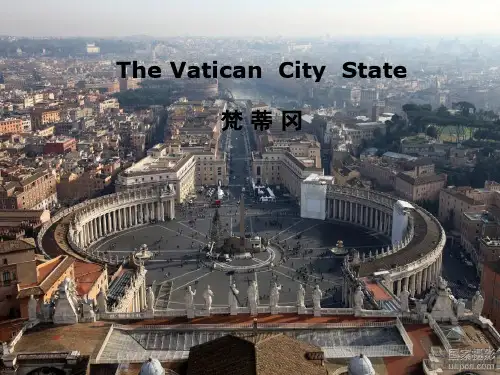
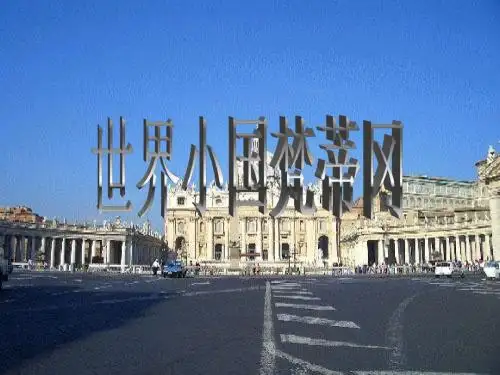
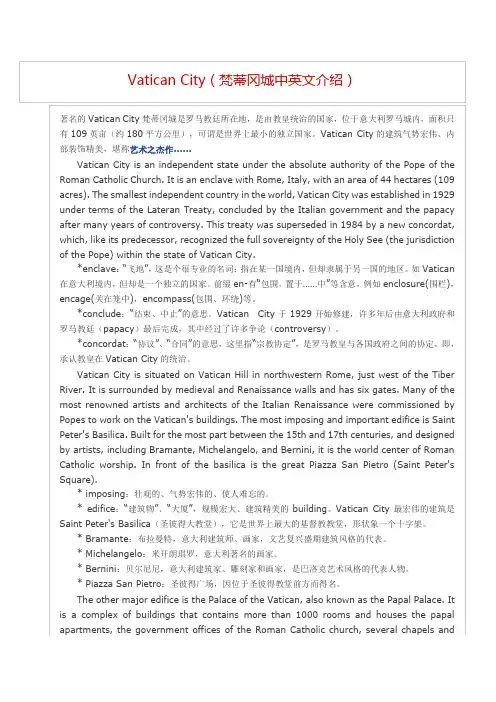
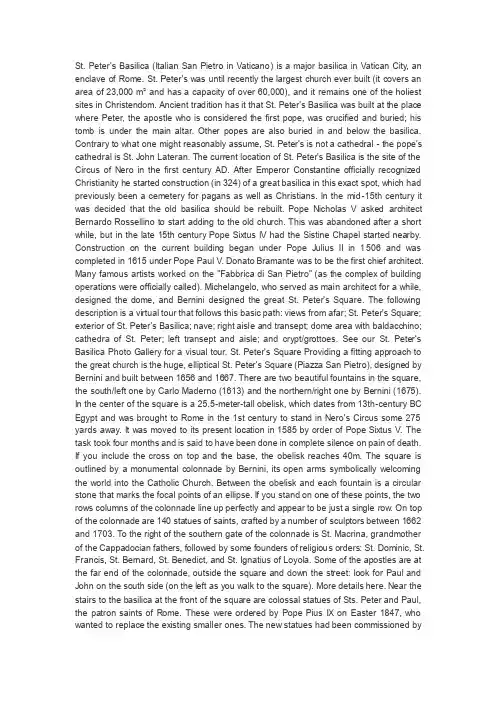
St. Peter's Basilica (Italian San Pietro in Vaticano) is a major basilica in Vatican City, an enclave of Rome. St. Peter's was until recently the largest church ever built (it covers an area of 23,000 m² and has a capacity of over 60,000), and it remains one of the holiest sites in Christendom. Ancient tradition has it that St. Peter's Basilica was built at the place where Peter, the apostle who is considered the first pope, was crucified and buried; his tomb is under the main altar. Other popes are also buried in and below the basilica. Contrary to what one might reasonably assume, St. Peter's is not a cathedral - the pope's cathedral is St. John Lateran. The current location of St. Peter's Basilica is the site of the Circus of Nero in the first century AD. After Emperor Constantine officially recognized Christianity he started construction (in 324) of a great basilica in this exact spot, which had previously been a cemetery for pagans as well as Christians. In the mid-15th century it was decided that the old basilica should be rebuilt. Pope Nicholas V asked architect Bernardo Rossellino to start adding to the old church. This was abandoned after a short while, but in the late 15th century Pope Sixtus IV had the Sistine Chapel started nearby. Construction on the current building began under Pope Julius II in 1506 and was completed in 1615 under Pope Paul V. Donato Bramante was to be the first chief architect. Many famous artists worked on the "Fabbrica di San Pietro" (as the complex of building operations were officially called). Michelangelo, who served as main architect for a while, designed the dome, and Bernini designed the great St. Peter's Square. The following description is a virtual tour that follows this basic path: views from afar; St. Peter's Square; exterior of St. Peter's Basilica; nave; right aisle and transept; dome area with baldacchino; cathedra of St. Peter; left transept and aisle; and crypt/grottoes. See our St. Peter's Basilica Photo Gallery for a visual tour. St. Peter's Square Providing a fitting approach to the great church is the huge, elliptical St. Peter's Square (Piazza San Pietro), designed by Bernini and built between 1656 and 1667. There are two beautiful fountains in the square, the south/left one by Carlo Maderno (1613) and the northern/right one by Bernini (1675). In the center of the square is a 25.5-meter-tall obelisk, which dates from 13th-century BC Egypt and was brought to Rome in the 1st century to stand in Nero's Circus some 275 yards away. It was moved to its present location in 1585 by order of Pope Sixtus V. The task took four months and is said to have been done in complete silence on pain of death. If you include the cross on top and the base, the obelisk reaches 40m. The square is outlined by a monumental colonnade by Bernini, its open arms symbolically welcoming the world into the Catholic Church. Between the obelisk and each fountain is a circular stone that marks the focal points of an ellipse. If you stand on one of these points, the two rows columns of the colonnade line up perfectly and appear to be just a single row. On top of the colonnade are 140 statues of saints, crafted by a number of sculptors between 1662 and 1703. To the right of the southern gate of the colonnade is St. Macrina, grandmother of the Cappadocian fathers, followed by some founders of religious orders: St. Dominic, St. Francis, St. Bernard, St. Benedict, and St. Ignatius of Loyola. Some of the apostles are at the far end of the colonnade, outside the square and down the street: look for Paul and John on the south side (on the left as you walk to the square). More details here. Near the stairs to the basilica at the front of the square are colossal statues of Sts. Peter and Paul, the patron saints of Rome. These were ordered by Pope Pius IX on Easter 1847, who wanted to replace the existing smaller ones. The new statues had been commissioned bythe previous pope for St. Paul Outside the Walls. Peter was sculpted by Giuseppe De Fabris in 1838-40 and stands 5.55m in height, on a pedestal 4.91m high. Paul was sculpted in 1838 by AdamoTadolini, and is also 5.55m in height, on a pedestal 4.91m high. Exterior of St. Peter's Basilica The dome of St. Peter's was designed by Michelangelo, who became chief architect in 1546. At the time of his death (1564), the dome was finished as far as the drum, the base on which domes sit. The dome was vaulted between 1585 and 1590 by the architect Giacomo della Porta with the assistance of Domenico Fontana, who was probably the best engineer of the day. Fontana built the lantern the following year, and the ball was placed in 1593. The great double dome is made of brick and is 42.3 metres in interior diameter (almost as large as the Pantheon), rising to 120 metres above the floor. In the early 18th century cracks appeared in the dome, so four iron chains were installed between the two shells to bind it. The four piers of the crossing that support the dome are each 60 feet (18 meters) across. Uniquely, Michelangelo's dome is not a hemisphere, but a parabola: it has a vertical thrust, which is made more emphatic by the bold ribbing that springs from the paired Corinthian columns, which appear to be part of the drum, but which stand away from it like buttresses, to absorb the outward thrust of the dome's weight. Above, the vaulted dome rises to Fontana's two-stage lantern, capped with a spire. The grand façade is 116 m wide and 53 m high. Built from 1608 to 1614, it was designed by Carlo Modeno. The central balcony is called the Loggia of the Blessings, and is used for the announcement of the new pope with "HabemusPapum" and his UrbietOrbi blessing. The relief under the balcony, by Buonvicino, represents Christ giving the keys to St. Peter. The facade is topped by 13 statues in travertine. From left, the statues represent: Thaddeus, Matthew, Philip, Thomas, James the Elder, John the Baptist, Christ the Redeemer (in the center), Andrew, John the Evangelist, James the Younger, Bartholomew, Simon and Matthias. St. Peter's statue in this set is inside. Two clocks are on either side; the one on the left is electrically operated since 1931, with its oldest bell dating to 1288. Stretching across the facade is the dedicatory inscription: IN HONOREM PRINCIPIS APOST PAVLVS V BVRGHESIVS ROMANVS PONT MAX AN MDCXII PONT VII (In honor of the prince of apostles; Paul V Borghese, pope, in the year 1612 and the seventh year of his pontificate) Between the façade and the interior is the portico. Mainly designed by Maderno, it contains an 18th century statue of Charlemagne by Cornacchini to the south, and an equestrian sculpture of Emperor Constantine by Bernini (1670) to the north.。
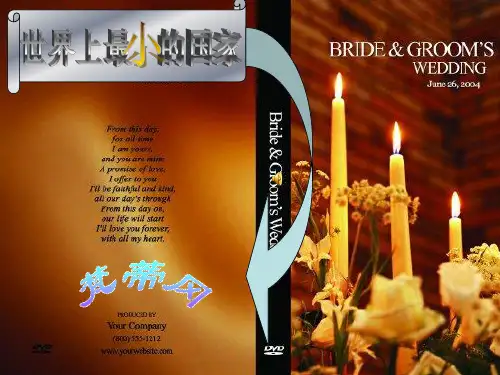
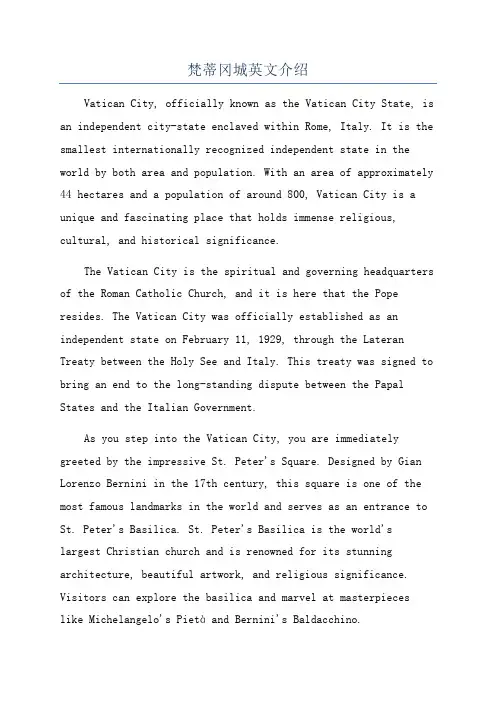
梵蒂冈城英文介绍Vatican City, officially known as the Vatican City State, is an independent city-state enclaved within Rome, Italy. It is the smallest internationally recognized independent state in the world by both area and population. With an area of approximately 44 hectares and a population of around 800, Vatican City is a unique and fascinating place that holds immense religious, cultural, and historical significance.The Vatican City is the spiritual and governing headquarters of the Roman Catholic Church, and it is here that the Pope resides. The Vatican City was officially established as an independent state on February 11, 1929, through the Lateran Treaty between the Holy See and Italy. This treaty was signed to bring an end to the long-standing dispute between the Papal States and the Italian Government.As you step into the Vatican City, you are immediately greeted by the impressive St. Peter's Square. Designed by Gian Lorenzo Bernini in the 17th century, this square is one of the most famous landmarks in the world and serves as an entrance to St. Peter's Basilica. St. Peter's Basilica is the world'slargest Christian church and is renowned for its stunning architecture, beautiful artwork, and religious significance. Visitors can explore the basilica and marvel at masterpieceslike Michelangelo's Pietà and Bernini's Baldacchino.Adjacent to St. Peter's Basilica is the Vatican Museums, which house an extensive collection of art and historical artifacts. The museums cover a vast area and include halls, galleries, and stunningly decorated rooms. The most famous section of the museums is the Sistine Chapel, famous for its ceiling painted by Michelangelo. The vividly painted ceiling depicts various scenes from the Book of Genesis and is considered one of the greatest masterpieces in Western art.Apart from St. Peter's Basilica and the Vatican Museums, Vatican City is home to numerous other significant buildings and sites. The Apostolic Palace, also known as the Vatican Palace,is the official residence of the Pope and is where he carries out his administrative duties. The papal apartments within the palace are not open to the public, but the public can visit the Vatican Gardens, which cover approximately half of the Vatican City's area and are renowned for their beauty and tranquility.Another important site within the Vatican City is the Vatican Library, one of the oldest and most extensive libraries in the world. It contains a vast collection of manuscripts, books, and historical documents dating back centuries. The library is not generally open to the public, but researchers and scholars can request access for academic purposes.Vatican City also boasts the Vatican Observatory, one of the oldest astronomical research institutions in the world. Theobservatory conducts scientific research and engages in discussions on the dialogue between science and religion.In addition to its religious and cultural significance, Vatican City also serves as a diplomatic hub. It is recognized as a sovereign state and maintains diplomatic relations with countries worldwide, including the United States, France, and the United Kingdom. The Pope, as the head of the Roman Catholic Church and the sovereign of Vatican City, also serves as the spiritual leader and moral authority for billions of Catholics around the world.。
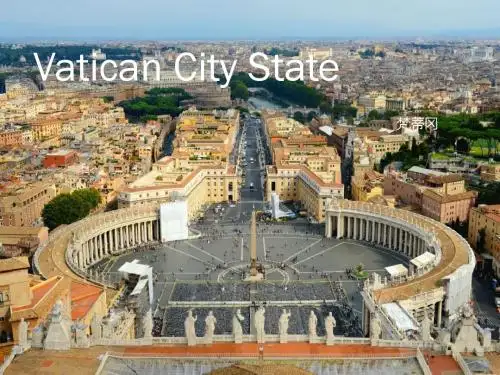
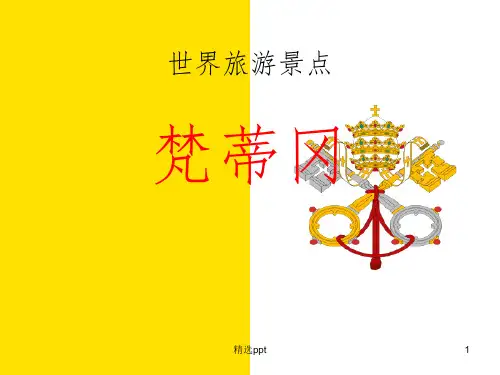
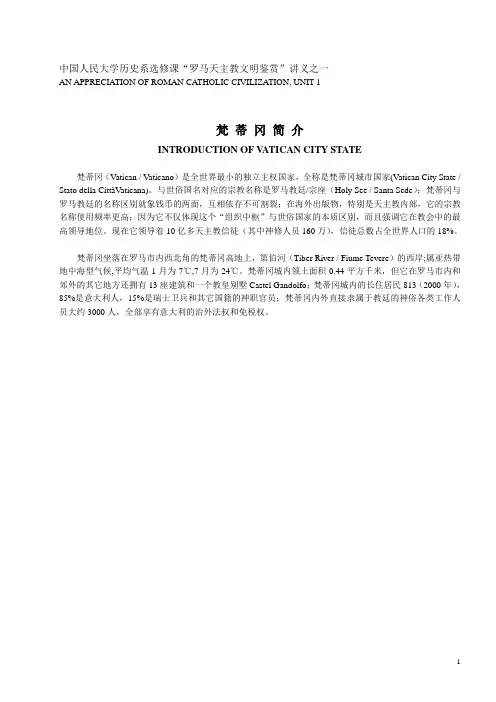
中国人民大学历史系选修课“罗马天主教文明鉴赏”讲义之一AN APPRECIATION OF ROMAN CATHOLIC CIVILIZATION, UNIT 1梵蒂冈简介INTRODUCTION OF V ATICAN CITY STATE梵蒂冈(Vatican / Vaticano)是全世界最小的独立主权国家,全称是梵蒂冈城市国家(Vatican City State / Stato della CittàVaticana)。
与世俗国名对应的宗教名称是罗马教廷/宗座(Holy See / Santa Sede);梵蒂冈与罗马教廷的名称区别就象钱币的两面,互相依存不可割裂;在海外出版物,特别是天主教内部,它的宗教名称使用频率更高;因为它不仅体现这个“组织中枢”与世俗国家的本质区别,而且强调它在教会中的最高领导地位。
现在它领导着10亿多天主教信徒(其中神修人员160万),信徒总数占全世界人口的18%。
梵蒂冈坐落在罗马市内西北角的梵蒂冈高地上,第伯河(Tiber River / Fiume Tevere)的西岸;属亚热带地中海型气候,平均气温1月为7℃,7月为24℃。
梵蒂冈城内领土面积0.44平方千米,但它在罗马市内和郊外的其它地方还拥有13座建筑和一个教皇别墅Castel Gandolfo;梵蒂冈城内的长住居民813(2000年),85%是意大利人,15%是瑞士卫兵和其它国籍的神职官员;梵蒂冈内外直接隶属于教廷的神俗各类工作人员大约3000人,全部享有意大利的治外法权和免税权。
图1. 梵蒂冈在罗马的位置图2. 梵蒂冈国旗图3. 梵蒂冈国徽国旗:1825年教皇利奥十二世(Leo / Leone XII, 1823-29)选定。
靠旗杆的左半面是黄色竖条;右半面白底色,一根红色丝带系着圣彼得专门打开天堂大门的钥匙,金黄色和银白色的两把钥匙交叉支撑着教皇的三重冠(tiara);钥匙的典故出自《圣经·马太福音》,耶稣对圣彼得说:“我要把天国的钥匙交给你,凡你在地上捆绑的,在天上也要捆绑;凡你在地上释放的,在天上也要释放”。
梵蒂冈城英文介绍:One of the most recognizable[1] structures in the world, one can t say theyre been to Washington D.C. until they have seen the White House. The home of the leader of the free world is open to the public five days a week from 10 noon.Originally known as the Executive Mansion[2], construction of the White House began in 1792 under the direction of George Washington. The structure was not pleted until 1800, so ironically[3] Washington is the only President not to live there.The executive mansion was torched by British troops in 1814, during the War of 1812. The structural damage caused by the fire was repaired but theexterior sandstone walls were still black with fire damage. The walls were then painted white, givingbirth to the nick name The White House. An act of Congress made this the official name in 1902.Every President has left his mark upon the White House. Thomas Jefferson added terraces to the east and west wings, Andrew Jackson installed running water,and Harry Truman added a porch. Bill Clintons addition to the White House was an indoor-running track(Used to relieve tension and cheeseburgers).In order to visit the White House, you must first pick up a free ticket from the White House Visitor Center located at 1450 Pennsylvania Ave. During the height of tourist season, tickets are nearlyimpossible to get. Get in line by 7AM (the facility opens at 7:30) and you might have a chance. Ignore the scalpers that are selling free tickets.Guided tours can be arranged by contacting your representative or senator. Be on the look-out for Wolf Blitzer or other famous White House correspondents. Due to recent developments in the news, the number of reporters that usually surround the White house have swelled dramatically.The White House tour probably ranks high on a visitors list of things to do while in Washington D.C.,but the process to get tickets will definitely test your determination. The White House is open Tues. Sat. from 10 AM Noon, but you need to get one of the free tickets for admittance. Herein lies the problem, because tickets for that days tours can only be picked up at the White House Visitors Center and they run out very quickly. Although the center opens at 7:30 AM,the line to get tickets starts to form sometime around five. Therefore most people have to be satisfied with seeing only the exterior of the White House. The Visitors Center has nice displays on the history ofthe White House to mollify the disappointed visitors who couldnt get tickets. Dont expect to get ticketsfor the tour if you arrive after 9 AM.If you are lucky enough to get tickets, they will be sted with the departure time of your tour. Bleachers have been set up on the Ellipse so visitors can sit until the tour staff collects them. The twenty minute tour consists of five rooms: The East Room, Green Room, Blue Room, Red Room and the State Dining Room.The Presidents GardenThe lovely White House gardens of today and those that preceded[4] them are the theme of the Presidents Garden organized by the White House Historical Association, the White House Curators Office, and the Superintendent of the Grounds fo rthe White House in cooperation with the National Park Service. Theexhibit traces the history of the White House grounds from the 1790s to the present day and displays more than 60 historic black and white and color photographs, paintings, documents and other illustrations from the past and present.White House Visitor Center, 1450 Pennsylvania Ave., NW. Open daily from 7:30am to 4pm. For moreinformation cal the National Park Service at (202)619-6350.。
八下英语作文介绍世界上最小的国家梵蒂冈Title: Introducing the Smallest Country in the World - Vatican CityNestled within the heart of Rome, Vatican City stands as a unique and fascinating microstate, renowned as the smallest country in the world. This tiny enclave, encompassing a mere 0.44 square kilometers, is home to the Holy See and the pope, the spiritual leader of the Catholic Church.Geographically, Vatican City is a city-state, completely surrounded by the Italian capital, Rome. Its boundaries are marked by ancient walls and gates, creating a sense of tranquility within the bustling city. Despite its size, Vatican City boasts a rich cultural heritage and historical significance.One of the most significant landmarks in Vatican City is St. Peter's Basilica, a magnificent church that serves as the center of the Catholic Church. Its intricate architecture and elaborate artwork attract millions of visitors every year. Inside, one can find Michelangelo's Pietà, a breathtaking sculpture of the Virgin Mary holding the body of Jesus.Another must-visit attraction is the Sistine Chapel, famous for its ceiling fresco painted by Michelangelo. The chapel, which serves as a papal chapel and a place where papalconclaves are held, is a testament to the incredible talent of the Renaissance master.Moreover, Vatican City houses the Vatican Museums, one of the largest and most important collections of art in the world. These museums showcase ancient sculptures, paintings, and artifacts, providing a glimpse into the rich history and culture of the Catholic Church.In addition to its cultural attractions, Vatican City also has its own laws, government, and postal system. The pope, as the head of the Holy See, serves as the supreme authority of the city-state.In conclusion, Vatican City, though small in size, is vast in its cultural and historical significance. It is a place where ancient traditions and modernity coexist, attracting millions of visitors from all over the world.。